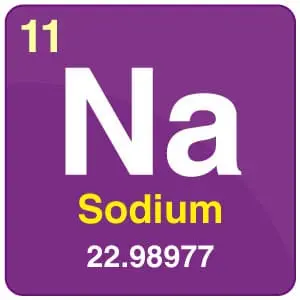Sodium
What is Sodium?
Sodium is a chemical element with atomic number 11 and the symbol Na, derived from the Latin natrium.
It’s a very reactive, silvery-white, and pliable metal. Sodium belongs to group 1 of the periodic table, which is an alkali metal. 23Na is the only stable isotope in it.
Since it is not found in nature, the free metal needs to be made from compounds. Sodium can be found in several minerals, including feldspar, sodalite, and halite (NaCl), and is the sixth most prevalent element in the crust of the Earth.
Since water has been eroding sodium ions from Earth’s rocks for centuries, many sodium salts are extremely water-soluble.
As a result, sodium and chlorine are the most frequently dissolved elements in the oceans by weight.
Humphry Davy isolated sodium for the first time in 1807 by electrolyzing sodium hydroxide.
Sodium chloride, or edible salt, is a de-icing agent and a nutrient for animals, including humans, while sodium hydroxide, or lye, is used in the production of soap, among many other beneficial sodium compounds.
All animals and certain plants require sodium as a necessary element. Since sodium ions make up the majority of the cations in extracellular fluid (ECF), they also play a vital role in determining the ECF compartment volume and osmotic pressure.
[Reference required] Hypernatremia is the term for the situation when the sodium concentration rises due to water loss from the ECF compartment.
ECF hypovolemia is a condition in which the ECF compartment shrinks due to isotonic loss of water and sodium.
Living human cells use the sodium-potassium pump to exchange two potassium ions pumped in for three sodium ions pumped out; when ion concentrations are measured across.
In the cell membrane from the inside to the outside, potassium measures approximately 40:1, and sodium measures approximately 1:10.
When the electrical charge in nerve cells dissipates, it allows the nerve impulse, or action potential, to be sent across the cell membrane. Sodium is essential for this process.
Characteristics
Physical
At room temperature and atmospheric pressure, sodium is a soft, silvery metal that reacts with airborne oxygen to generate sodium oxides.
An inert gas or oil is typically used to store bulk salt. A knife can be used to cut sodium metal with ease. It is an efficient heat and electricity conductor.
Among the elemental metals, sodium is the third least dense due to its large atomic radius and low atomic mass.
It is also one of only three metals that can float on water, the other two being potassium and lithium.
Sodium exhibits periodic patterns down the group, with its melting (98 °C) and boiling (883 °C) temperatures being lower than lithium’s but higher than those of the heavier alkali metals, potassium, rubidium, and cesium.
At high pressures, these characteristics drastically alter: at 1.5 Mbar, the material’s hue shifts from silvery metallic to black; at 1.9 Mbar, it turns transparent and red; and at 3 Mbar, sodium solidifies into a clear, transparent substance.
These high-pressure allotropes are electrides and insulators in equal measure. Sodium and its compounds burn yellow in a flame test because the excited 3s electrons in sodium release a photon as they transition from 3p to 3s.
The wavelength of this photon is approximately 589.3 nm, which corresponds to the D line.
The D line is broken into two at 589.0 and 589.6 nm by spin-orbit interactions involving the electron in the 3p orbital; hyperfine structures incorporating both orbitals result in many more lines.
Isotopes
There are other sodium isotopes known, but only 23Na is stable. When two carbon atoms combine in a star that is at least three solar masses in mass and temperature above 600 mega kelvins, 23Na is produced during the carbon-burning process in stars.
Cosmic ray spallation produces two radioactive, cosmogenic isotopes: 22Na, which has a half-life of 2.6 years, and 24Na, which has a half-life of 15 hours; the half-lives of the other isotopes are less than one minute.
There are two nuclear isomers that have been found, with 24Na having a half-life of about 20.2 ms being the longer-lived one.
A victim’s neutron radiation dosage can be determined by measuring the ratio of 24Na to 23Na. Acute neutron radiation, such as that from a nuclear criticality accident, changes some of the stable 23Na in human blood to 24Na.
Chemistry
Eleven electrons are present in sodium atoms, which is one more than the stable configuration of the noble gas neon.
There are 495.8 kJ/mol for the first ionization and 4562 kJ/mol for the second. Consequently, sodium typically combines with the Na+ cation to form ionic compounds.
Metallic Sodium
In general, metallic sodium is more reactive than lithium and less reactive than potassium. Potassium and lithium have even greater negative potentials than sodium metal, which has a typical reduction potential for the Na+/Na pair of −2.71 volts.
Salts and Oxides
Sodium compounds hold great commercial significance, especially in the glass, paper, soap, and textile sectors.
- Table salt (NaCl)
- soda ash (Na2CO3)
- baking soda (NaHCO3)
- caustic soda (NaOH)
- sodium nitrate (NaNO3).
Tri- and di-sodium phosphates, sodium thiosulfate (Na2S2O3·5H2O), and borax (Na2B4O7·10H2O) are the most significant sodium compounds.
Sodium is thought of as a hard Lewis acid since it is typically ionically linked to anions and water in compounds.
The majority of soaps are fatty acid sodium salts. When compared to potassium soaps, sodium soaps seem “harder” and have a greater melting point.
Sodium reacts with water exothermically, just like the other alkali metals do. Flammable hydrogen gas and caustic soda (sodium hydroxide) are the products of the process.
It mostly burns to sodium peroxide and some sodium oxide when burned in air.
Aqueous Solutions
Sodium frequently forms halides, sulfates, nitrates, carboxylates, and carbonates—compounds that are soluble in water.
The principal aqueous species are the aqua complexes [Na(H2O)n]+, where n = 4–8; X-ray diffraction studies and computer simulations show that n = 6.
Due to their usual strong affinity for water, sodium salts rarely precipitate directly from aqueous solutions.
Sodium bismuthate (NaBiO3) is an exception, as it dissolves in hot water and is insoluble in cold.
Sodium salts are typically separated as solids by evaporation or precipitation with an organic antisolvent, such as ethanol, due to the high solubility of its constituents; for instance, just 0.35 g/L of sodium chloride will dissolve in ethanol.
One potential application for crown ethers is as a phase-transfer catalyst (15-crown-5). Ion-selective electrodes are used in potentiometry or atomic absorption spectrophotometry to measure the sodium content of materials.
Electrides and Sodides
Similar to other alkali metals, sodium also dissolves in ammonia and certain amines to form richly colored solutions, which evaporate to leave a sparkling layer of metallic sodium.
The coordination complex (Na(NH3)6)+) is present in the solutions, and cryptands allow these complexes to be isolated as crystalline solids.
The positive charge of the complex is counterbalanced by electrons as anions. Sodium combines to produce complexes with cryptands, crown ethers, and other ligands.
For instance, 15-crown-5 has a high affinity for sodium because the ion (1.9 Å) can fit inside its cavity, which has a size of 1.7–2.2 Å.
Similar to crown ethers and other ionophores, cryptands also exhibit a strong affinity for the sodium ion.
This property allows them to be added to sodium in ammonia solutions via disproportionation, thereby yielding derivatives of the alkaline Na−.
Organosodium Compounds
A large number of organosodium compounds are ready. The C-Na bonds’ strong polarity causes them to act like sources of carbanions, which are salts that have organic anions.
Sodium cyclopentadienide (NaC5H5) and trityl sodium ((C6H5)3CNa) are two examples of well-known derivatives.
When Na and naphthalene are mixed in ethereal solutions, sodium naphthalene, or Na+[C10H8•]−, a potent reducing agent, is formed.
Intermetallic Compounds
Many metals, including potassium, calcium, lead, and elements in groups 11 and 12, can be combined with sodium to create alloys.
KNa2 and NaK are formed by potassium and sodium. NaK, which contains 40–90% potassium, is liquid at room temperature.
It performs admirably as an electrical and thermal conductor. The electrolytic synthesis of sodium from a binary salt mixture of NaCl-CaCl2 and the ternary mixture of NaCl-CaCl2-BaCl2 yields sodium-calcium alloys as byproducts.
Because calcium and sodium are only slightly miscible, the 1-2% of calcium that dissolves in the sodium that is obtained from these mixes can be precipitated by filtering and cooling to 120 °C.
Lead and sodium are perfectly miscible when in a liquid form. Alloys containing lead and sodium can be made in a number of ways.
There are two methods to melt them together: one is to electrolytically deposit sodium on molten lead cathodes.
The sodium-lead alloys NaPb3, NaPb, Na9Pb4, Na5Pb2, and Na15Pb4 are among many that are known.
Additionally, sodium can form alloys with silver (NaAg2) and gold (NaAu2). It is known that group 12 metals, such as zinc, cadmium, and mercury, can form alloys with sodium.
Zinc and cadmium alloys are NaZn13 and NaCd2. In NaHg, NaHg4, NaHg2, Na3Hg2, and Na3Hg, sodium and mercury combine to create.
History
Salt has historically been a valuable commodity due to its significance for human health, as seen by the English word salary, which comes from the Latin salarium, which refers to the salt wafers that Roman soldiers occasionally received in addition to their other pay.
A sodium compound known by the Latin name sodium was employed as a headache cure in medieval Europe.
Since sodium carbonate, or soda, was known to relieve headaches in antiquity, it is believed that the name sodium came from the Arabic suda, which means headache.
While sodium, often known as soda, had long been known in compounds, it wasn’t until 1807 that Sir Humphry Davy separated the metal by electrolyzing sodium hydroxide.
The names Natronium and Kalium were suggested by German physicist and chemist Ludwig Wilhelm Gilbert in 1809 for the “sodium” and “potassium” respectively used by Humphry Davy.
The element’s Neo-Latin name, natrium, refers to the Egyptian natron, a naturally occurring mineral salt primarily composed of hydrated sodium carbonate.
Jöns Jakob Berzelius first published the chemical term for sodium in his system of atomic symbols in 1814.
Before being surpassed by other sodium compounds, naptron had a number of significant industrial and domestic applications throughout history.
Flames are intensely yellow when sodium is present. Kirchhoff and Bunsen reported in Annalen der Physik und Chemie in 1860 that a sodium flame test had a high sensitivity.
We observed the nonluminous flame before the slit and detonated 3 mg of sodium chlorate with milk sugar in the corner of our 60 m³ room that was the furthest away from the apparatus.
It eventually lit up bright yellow and had a prominent sodium line, which vanished after ten minutes.
We can simply compute that one part by weight of air could not contain more than 1/20 millionth weight of sodium based on the weight of the sodium salt and the amount of air in the room.
Occurrence
Sodium is the seventh most prevalent element and the fifth most abundant metal on Earth, after aluminum, iron, calcium, and magnesium, and before potassium.
It makes up 2.27% of the Earth’s crust. There are 10.8 grams of sodium per liter in the ocean.
This highly reactive element is seldom encountered in pure form. Numerous minerals contain it; some are very soluble in it, such as natron and halite, while others are much less soluble, like as zeolite and amphibole.
Some sodium minerals, such as feldspar and cryolite, are insoluble because of their polymeric anions, which are polysilicates in the case of feldspar.
Sodium makes up.002% of all atoms in the cosmos and is the fifteenth most abundant element in the universe with an abundance of 20,000 parts per billion.
Astronomical Observations
The yellow-orange region of the spectrum contains a very strong spectral line for atomic sodium, which is the same line used in sodium-vapor street lights.
In many kinds of stars, including the Sun, this manifests as an absorption line. Joseph von Fraunhofer initially examined the line in 1814 while looking into what are now known as the Fraunhofer lines—lines in the solar spectrum.
Though it is now understood to be a collection of closely spaced lines divided by a fine and hyperfine structure, Fraunhofer termed it the “D” line.
The D line’s strength enables detection in numerous other astronomical situations. Any star whose surface is cool enough for sodium to exist in its atomic form—as opposed to an ionized form—will exhibit it.
This translates to roughly F-type and colder stars. The apparent sodium absorption line seen in many other stars is actually the result of gas in the foreground interstellar medium.
High-resolution spectroscopy can be used to differentiate between the two because interstellar lines are significantly thinner than those caused by star rotation.
Moreover, sodium has been found in a wide range of Solar System conditions, such as the exosphere of the Moon, the atmosphere of Mercury, and many other bodies.
A sodium tail is seen on certain comets; Comet Hale-Bopp studies in 1997 were the first to reveal this feature. Even some extrasolar planets’ atmospheres have been found to contain sodium through the use of transit spectroscopy.
Commercial production
Metallic sodium is manufactured every year in small quantities, about 100,000 tonnes, and is exclusively used in very specific applications.
As the initial stage of the Deville process for the creation of aluminum, the commercial production of metallic sodium began in the late 1800s when sodium carbonate underwent carbothermal reduction at 1100 °C.
Na2CO3 +2 C → 2Na + 3 CO
The necessity to produce sodium arose from the enormous demand for aluminum. Large amounts of sodium were no longer required after the Hall-Héroult method, which produces aluminum by electrolyzing a molten salt bath, was developed.
In 1886, a comparable method based on the reduction of sodium hydroxide was created. Based on a 1924 patent, sodium is currently generated commercially by electrolyzing molten sodium chloride.
This is accomplished in a Downs cell by combining calcium chloride and sodium chloride to drop the melting point below 700 °C.
No calcium will deposit at the cathode because it is less electropositive than sodium. Compared to the earlier Castner technique, which involved electrolyzing sodium hydroxide, this approach is less costly.
High-purity sodium can be distilled one or more times if necessary. Because sodium is difficult to store and ship, its market is unstable.
To avoid sodium oxide or sodium superoxide from forming on the surface, it must be stored in anhydrous mineral oil or under a dry, inert gas atmosphere.
Uses
Despite the fact that metallic sodium has certain significant uses, compounds—millions of tons of sodium hydroxide, carbonate, and chloride are created each year—are the main uses for sodium.
Sodium bicarbonate is used in baking, as a rising agent, and in soda blasting; sodium chloride is widely used as a preservative and for anti-icing and de-icing.
In addition to potassium, sodium is often added to major medications in order to increase their bioavailability; although potassium is often the superior ion, sodium is used due to its cheaper cost and atomic weight.
In organic chemistry, sodium hydride serves as a base for a number of reactions, including the aldol reaction.
The principal uses of metallic sodium are in the manufacture of indigo, triphenylphosphine, sodium azide, and sodium borohydride.
The synthesis of titanium metal and tetraethyllead was previously a common usage; but, around 1970, sodium output began to diminish due to improved titanium manufacturing techniques and a shift away from TEL.
In addition, sodium is employed as a reducing agent for metals when alternative materials are inefficient, as well as an alloying metal and an anti-scaling agent.
It should be noted that sodium ions are substituted for the ions in the water, not the free element, as a scaling agent.
In cities, sodium plasma (“vapor”) lamps are frequently used for street lighting. As the pressure increases, the light emitted by these lamps changes from yellow-orange to peach.
Sodium works as a desiccant on its own or in combination with potassium; when the desiccate is dry, it reacts with benzophenone to produce a vivid blue color.
Sodium is employed in a number of reactions in organic synthesis, including the Birch reduction and the sodium fusion test, which is used to analyze molecules qualitatively.
Alkynes can be reduced to trans-alkenes by dissolving sodium in an ammonia solution. Sodium also reacts with alcohol to produce alkoxides.
Artificial laser guide stars are produced by lasers that emit light at the sodium D line, helping to improve the adaptive optics of visible-light telescopes that are fixed on land.
Heat Transfer
Because liquid sodium has the high thermal conductivity and low neutron absorption cross-section needed to create a high neutron flux in the reactor, it is employed as a heat transfer fluid in sodium-cooled fast reactors.
Sodium’s high boiling point makes it possible for the reactor to run at ambient (normal) pressure, but it also has strong reducing characteristics and is opaque, which makes visual maintenance difficult.
While sodium burns slowly in the air, it will burst when it comes into contact with water. A small radiation risk may arise from the production of radioactive sodium-24 during operation due to neutron bombardment.
The radioactivity ceases a few days after the reactor is removed. NaK is utilized when a reactor needs to be shut down periodically.
NaK is a liquid at normal temperature, so the coolant in the pipes doesn’t solidify. In this instance greater care is needed to identify and prevent leaks.
The pyrophoricity of potassium. Poppet valves in high-performance internal combustion engines are another example of heat transfer use; the valve stems are partially filled with sodium and function as a heat pipe to cool the valves.
Biological Role
Biological Role in Humans
Sodium is a necessary mineral for human health that controls blood pressure, pH, osmotic balance, and blood volume. It is estimated that a newborn’s minimal physiological requirement for sodium is 120 milligrams per day, whereas an adult over the age of 10 requires 500 milligrams per day.
Diet
The main source of sodium in the diet is sodium chloride, or salt, which is used as a flavoring and preservative in goods like jerky and pickled preserves.
The majority of sodium chloride consumed in the United States comes from processed foods.
Additional sources of salt include foods that naturally contain it as well as food additives such as sodium benzoate, baking soda (sodium bicarbonate), sodium nitrite, and monosodium glutamate (MSG).
Although the average American eats 3.4 grams of salt daily, the U.S. Institute of Medicine set a safe upper intake level of 2.3 grams.
The American Heart Association suggests limiting your daily sodium intake to 1.5 grams.
High Sodium Consumption
Excessive sodium intake is harmful and may cause changes in the heart’s mechanical function. Increased blood pressure, heart disease, stroke, and chronic renal disease are also linked to increased sodium intake.
High Blood Pressure
increased blood pressure and increased sodium intake are strongly correlated. Research indicates that cutting back on sodium by two grams a day typically results in a two to four mm Hg drop in systolic blood pressure.
An estimated 9–17% fewer occurrences of hypertension would result from such a reduction in sodium intake.
Every year, 7.6 million premature deaths globally are attributed to hypertension. (Since chlorine and trace chemicals make up the remaining 39.3% of salt, 2.3 g of sodium is equivalent to 5.9 g, or 5.3 ml, of salt, or roughly one US teaspoon.
According to one study, those with or without hypertension who had a daily urine excretion of fewer than 3 grams of sodium (i.e., a daily intake of less than 3 g/d) were at greater risk of dying, or having a stroke.
Or having a heart attack than those who expelled 4 to 5 grams. In individuals with hypertension, levels of 7 g or more per day were linked to increased mortality and cardiovascular events, however.
This correlation was not observed in individuals without hypertension. Adults with hypertension and prehypertension, according to the US FDA, should limit their daily sodium consumption to 1.5 grams.
Physiology
The body’s sodium and fluid concentrations are controlled by the renin-angiotensin system. Renin is produced when the kidneys’ salt and blood pressure levels drop.
Renin then creates aldosterone and angiotensin, which encourage the kidneys to reabsorb sodium back into the bloodstream.
Renin synthesis is reduced and the sodium concentration returns to normal as the concentration of sodium rises. An essential electrolyte for neuron activity and osmoregulation between cells and extracellular fluid is sodium (Na+).
Sodium/potassium channels and Na+/K+-ATPase, an active transporter that pumps ions against the gradient, enable this in all mammals.
The most common metallic ion in extracellular fluid is sodium. In medicine, abnormally high or low blood sodium levels in humans are referred to as.
Hyponatremia and hypernatremia. Genetic factors, aging, or chronic vomiting or diarrhea may be the cause of these diseases.
Biological Role in Plants
Sodium is a micronutrient that helps with metabolism in C4 plants, particularly with phosphoenolpyruvate regeneration and chlorophyll synthesis.
In others, it serves as a potassium substitute in a number of capacities, including turgor pressure maintenance and stomata opening and shutting assistance.
Excessive quantities of sodium in the cytoplasm can cause enzyme inhibition, which in turn causes necrosis and chlorosis; excess sodium in the soil can limit the intake of water.
As a result, certain plants have evolved defense systems that prevent sodium from entering the roots, store it in cell vacuoles, and prevent salt from moving from the roots to the leaves.
Old plant tissue may also store excess sodium, preventing harm to newly emerging growth. Because of their adaptations, halophytes may thrive in environments high in salt.
Safety and Precautions
When sodium comes into contact with water, it transforms into caustic sodium hydroxide and flammable hydrogen; severe burns can result from ingestion or moisture contact on the skin, eyes, or mucous membranes.
In the presence of water, sodium spontaneously explodes because sodium hydroxide (which dissolves in the water and releases more surface area) and hydrogen (which is extremely explosive) are formed.
On the other hand, a comparatively moderate fire is observed when sodium is exposed to air, ignites, or reaches autoignition, which is said to happen when a pool of molten sodium reaches 290 °C, or 554 °F.
When large, non-molten bits of sodium are present, a protective layer eventually forms, slowing down the oxygen reaction.
Sodium fires are accelerated by water-based fire extinguishers. On sodium fire, those based on carbon dioxide and bromochlorodifluoromethane need not be employed.
Class D fires are metal fires; however, not all Class D extinguishers work well on sodium fires. Met-L-X is a sodium fire extinguisher chemical that works well.
Lith-X, which contains graphite powder and an organophosphate flame retardant, and dry sand are two more efficient agents.
Nuclear reactors can avoid sodium fires by isolating sodium from oxygen through surrounding inert gas-filled pipes.
Catch pan systems are a sort of diversified design that prevents sodium fires of the pool type. Leaking sodium is gathered and stored in an oxygen-free leak-recovery tank.
Compared to solid sodium fires, handling liquid sodium fires can be more hazardous, especially if one lacks appropriate experience handling molten sodium safely.
R. J. Gordon writes in a technical study for the US Fire Administration (emphasis in original) that Sodium is extremely difficult to put out once it ignites.
As previously mentioned, it will react aggressively with water and any other water-containing extinguishing agent.
It will also react with the majority of dry chemical agents, carbon dioxide, and halogen compounds, among many other common extinguishing agents.
The only entirely dry inert materials that can be used to bury a small amount of burning sodium and prevent oxygen from reaching the metal are Class D extinguishing agents, soda ash, graphite, diatomaceous earth, or sodium chloride.
These materials are the only safe and effective extinguishing agents. Even a tiny bit of water in the extinguishing chemical can react with the burning sodium to generate an explosion, thus it must be completely dry.
Because of its chemical stability, sodium chloride is accepted as an extinguishing medium. However, because it is hygroscopic—that is, it attracts and retains water molecules on the surface of salt crystals—it needs to be kept completely dry in order to be used as an extinguishing agent properly.
A small amount of moisture is also present in the structure of every sodium chloride crystal.
Because molten sodium is far more reactive than a solid mass, it can be exceedingly harmful. Every sodium atom is free and mobile in the liquid state, allowing it to instantly mix with any accessible oxygen atom or other oxidant.
Any gaseous byproduct will form a quickly expanding gas bubble inside the molten mass. Such a reaction can occur with even very small amounts of water.
Any quantity of water added to a pool of molten sodium will probably result in a catastrophic explosion inside the liquid mass, ejecting the molten sodium from the container and releasing the hydrogen as a quickly expanding gas.
The burning happens at the liquid’s surface when molten sodium is present in the fire.
The pool of burning liquid sodium can be covered with an inert layer created by applying an inert gas, such as nitrogen or argon, but the gas must be applied very softly and contained over the surface.
In a molten mass of burning sodium, most powdered chemicals used to put out minor fires in solid pieces or shallow pools—apart from soda ash—sink to the bottom, allowing the burning sodium to float to the top and continue to burn.
If the sodium is burning within a container, it might be possible to put out the fire by sealing the container with a cover to keep oxygen out.
FAQ
What does sodium do in your body?
Sodium is a necessary mineral that the body needs in very small amounts (as long as significant perspiration doesn’t happen) to keep bodily fluids balanced and muscles and nerves functioning properly. But the majority of Americans eat too much of it, and they might not even be aware of it.
What is sodium used for?
Common salt, often known as sodium chloride, is the most prevalent form of sodium. In the winter, it’s used to de-ice roads and add to food. It is a feedstock for the chemical industry as well. Another helpful sodium salt is sodium carbonate, usually known as washing soda.
Are salt and sodium the same?
Approximately 40% sodium and 60% chloride makeup salt, also referred to as sodium chloride. It adds taste to meals and binders. Because bacteria cannot survive in an environment with high salt content, it also serves as a food preservative.
What is the formula for sodium?
Sodium has an atomic number of 11 and the chemical formula is Na. The most often utilized metal in extremely soft chemical compounds is sodium. The fact that it is easily cut with a knife is very crucial.
What is the normal sodium level?
It promotes the function of your muscles and nerves, helps to keep your blood pressure within normal limits, and controls the fluid balance in your body. A blood sodium level of 135 to 145 milliequivalents per liter (mEq/L) is considered normal. When the sodium level in your blood drops below 135 mEq/L, you have hyponatremia.
How much sodium per day?
For adults 14 years of age and up, the daily allowance is 2,300 milligrams (mg) as recommended by American nutrition experts. A daily salt intake of no more than 2,000 mg is advised by the World Health Organization. The majority of the salt in meals is concealed in prepared foods.
How to increase sodium?
Some of the greatest items to eat are cheese, dairy products, carrots, biscuits, and so on if you want to up your sodium intake. Up the amount of salt you eat: As a dietary source of sodium, one might increase their intake of salt.








5 Comments